历史
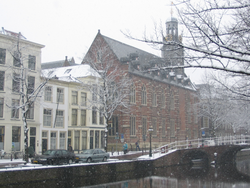
The Academy building of the Leiden university
In 1575, the emerging Dutch Republic did not have any universities in its northern heartland. The only other university in the Netherlands was in southern Leuven, firmly under Spanish control. The scientific renaissance had begun to highlight the importance of academic study, so Prince William founded the first Dutch university in Leiden as a reward for the heroic defence of Leiden against Spanish attacks in the previous year. Ironically, the name of Philip II of Spain, William's adversary, appears on the official foundation certificate, as he was still the de jure count of Holland. It is traditionally said that the citizens of Leiden were offered the choice between a university and a certain exemption from taxes, and that the citizens believed that a tax law could be rescinded, whereas the great universities of Europe had survived for many centuries. Originally located in the convent of St Barbara, the university moved to the convent of the White Nuns in 1581, a site which it still occupies, though the original building was destroyed in 1616.
The presence within half a century of the date of its foundation of such scholars as Justus Lipsius, Joseph Scaliger, Franciscus Gomarus, Hugo Grotius, Jacobus Arminius, Daniel Heinsius and Gerhard Johann Vossius, at once raised Leiden university to the highest European fame, a position which the learning and reputation of Jacobus Gronovius, Herman Boerhaave, Tiberius Hemsterhuis and David Ruhnken, among others, enabled it to maintain down to the end of the 18th century.
At the end of the nineteenth century, Leiden University again became one of Europe's leading universities. At the world’s first university low-temperature laboratory, professor Heike Kamerlingh Onnes achieved temperatures of only one degree above absolute zero of -273 degrees Celsius. In 1908 he was also the first to succeed in liquifying helium and can be credited with the discovery of the superconductivity in metals.
Kamerlingh Onnes was awarded the Nobel Prize for Physics in 1913. Three other professors received the Nobel Prize for their research performed at Universiteit Leiden: Hendrik Antoon Lorentz and Pieter Zeeman received the Nobel Prize for their pioneering work in the field of optical and electronic phenomena, and the physiologist Willem Einthoven for his invention of the string galvanometer, which among other things, enabled the development of electrocardiography.
These Nobel prize winners, but also the physicists Albert Einstein and Paul Ehrenfest, the Arabist and Islam expert Christiaan Snouck Hurgronje, the law expert Cornelis van Vollenhoven and historian Johan Huizinga, were among those who pushed the university into a place of international prominence during the 1920s and 1930s. In 2005 the manuscript of Einstein on the quantum theory of the monatomic ideal gas (the Einstein-Bose condensation) was discovered in one of Leiden's libraries.
At present, Leiden has a firmly established international position among the top research institutes in many fields, including the natural sciences, medicine, social and behavioural sciences, law, arts and letters. Of the fifty-five Spinozapremie (the highest scientific award of The Netherlands), twelve were granted to professors of the Universiteit Leiden. Literary historian Frits van Oostrom was the first professor of Leiden to be granted the Spinoza award for his work on developing the NLCM centre (Dutch literature and culture in the Middle Ages) into a top research centre. Other Spinozapremie winners are linguists Frederik Kortlandt and Pieter Muysken, mathematician Hendrik Lenstra, Carlo Beenakker, who works in the field of mesoscopic physics, Ewine van Dishoeck, astronomer at Leiden Observatory, transplantation biologist Els Goulmy, clinical epidemiologist Frits Rosendaal, Rien van IJzendoorn professor of education and child studies, physicist Jan Zaanen, archeologist Wil Roebroeks and neurologist Michel Ferrari. Among other leading professors are Wim Blockmans, professor of Medieval History, and Willem Adelaar, professor of Amerindian Languages.
The portraits of many famous professors since the earliest days hang in the university aula, one of the most memorable places, as Niebuhr called it, in the history of science.
The University Library, which has more than 3.5 million books and fifty thousand journals, also has a number of internationally renowned special collections of western and oriental manuscripts, printed books, archives, prints, drawings, photographs, maps, and atlases. Scholars from all over the world visit Leiden University Library, the oldest in the Netherlands. The research activities of the Scaliger Institute focus on these special collections and concentrate particularly on the various aspects of the transmission of knowledge and ideas through texts and images from antiquity to the present day.
Among the institutions affiliated with the university are The KITLV or Royal Netherlands Institute of Southeast Asian and Caribbean Studies (founded in 1851), the observatory 1633; the natural history museum, with a very complete anatomical cabinet; the museum of antiquities (Museum van Oudheden), with specially valuable Egyptian and Indian departments; a museum of Dutch antiquities from the earliest times; and three ethnographical museums, of which the nucleus was Philipp Franz von Siebold's Japanese collections. The anatomical and pathological laboratories of the university are modern, and the museums of geology and mineralogy have been restored.
The Hortus Botanicus (botanical garden) is the oldest botanical garden in the Netherlands, and one of the oldest in the world. Plants from all over the world have been carefully cultivated here by experts for more than four centuries. The Clusius garden (a reconstruction), the 18th century Orangery with its monumental tub plants, the rare collection of historical trees hundreds of years old, the Japanese Siebold Memorial Museum symbolising the historical link between East and West, the tropical greenhouses with their world class plant collections, and the central square and Conservatory exhibiting exotic plants from South Africa and southern Europe.
Research at Leiden is well developed. There are many university research institutes and Leiden participates in over forty nation-wide research schools, twelve of which being located in the heart of Leiden.
The institution
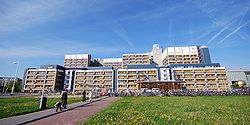
The Leiden University Medical Center
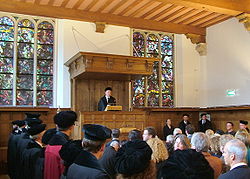
A new professor's inauguration lecture in the
Academiegebouw, 2008
The university has no central campus; its buildings are spread over the city. Some buildings, like the Gravensteen, are very old, while buildings like Lipsius and Gorlaeus are much more modern. The university is divided into six major faculties which offer approximately 50 undergraduate degree programs and over 100 graduate programs.
Education
Undergraduate programs
Most of the university's departments offer their own degree program(s). Undergraduate programs lead to either a B.A., B.Sc. or LL.B. degree. Other degrees, such as the B.Eng. or B.F.A., are not awarded at Leiden University.
| Faculties |
|
| Humanities |
网址 |
| Law |
网址 |
| Medicine or LUMC |
网址 |
| Mathematics and Natural Sciences |
网址 |
| Social and Behavioural sciences |
网址 |
| Archaeology |
网址 |
|
- African Languages and Cultures
- Archeology
- Arabic, Persian and Turkish Languages and Cultures
- Art History
- Assyriology
- Astronomy
- Biology
- Biomedical Sciences
- Bio-Pharmaceutical Sciences
- Chemistry
- Chinese Languages and Cultures
- Classics
- Comparative Indo-European Linguistics
- Computer Science
- Criminology
- Cultural Anthropology
- Developmental Sociology
- Dutch Language and Literature
- Dutch Studies
- Educational Sciences
- Egyptian Languages and Cultures (Egyptology)
- English Language and Culture
- French Language and Culture
- German Language and Culture
- History
- Hebrew and Aramaic Languages and Cultures
- Indian American Studies
|
- Indology (South and central Asia)
- Indonesian Languages and Cultures
- Italian Language and Culture
- Japanese Languages and Cultures
- Korean Languages and Cultures
- 拉丁语 American Studies (Spanish Languages and Cultures)
- Law (General Dutch Law track)
- Linguistics
- Life Science and Technology
- Literature
- Mathematics
- Medicine (6-year track)
- Molecular Science and Technology
- Near Eastern Studies
- New Persian Languages and Cultures (Turkish)
- Notarial Law
- Philosophy
- Physics
- Political Science
- Public Administration
- Psychology
- Russian Studies
- Slavic Languages and Literatures
- Southeast Asia and Oceania Languages and Cultures
- Tax Law
- Theology
- World Religion Studies
|
Graduate studies
Students can choose from a range of graduate programs. Most of the above mentioned undergraduate programs can be continued with either a general or a specialised graduate program. Leiden University offers more than 100 graduate programs leading to either M.A., M.Sc., M.Phil., or LL.M. degrees. The M.Phil. is a special research degree and only awarded by selected departments of the university (mostly in the fields of Arts, Social Sciences, Archeology, Philosophy, and Theology). Admission to these programs is highly selective and primarily aimed at those students opting for an academic career.
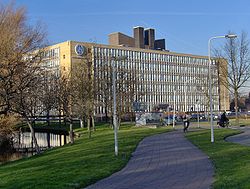
The Pieter de la Court-building, the main building of the Faculty of Social and Behavioral Sciences
Some of the notable graduate programs are
- Air and Space Law
- Asian Studies
- Bioinformatics
- Chemistry
- Industrial Ecology M.Sc. (track)
- DNA Computing
- Drug Delivery Technology and Biopharmaceutics
- European Law
- European and International Business Law
- European Union Studies
- Evolutionary and Ecological Sciences
- Functional Genomics
|
- History
- ICT in Business
- Public International Law
- International Relations and Diplomacy
- Islamic Studies
- Life Science and Technology
- Linguistics
- Mathematics
- Media Technology
- Nanoscience
- Philosophy of a Specific Discipline
- Toxicology
|
Doctorate programs
In addition, most departments, affiliated (research)institutes or faculties offer doctorate programs or positions, leading to the Ph.D degree. Most of the Ph.D. programs offered by the university are concentrated in several research schools or institutes.
Research schools and affiliated institutes
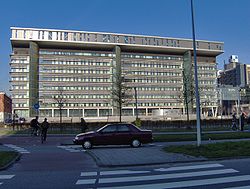
Research building of the Leiden University Medical Centre
Leiden University has more than 50 research and graduate schools and institutes. Some of them are fully affiliated with one faculty of the university, while others are interfaculty institutes or even interuniversity institutes.
| Institute |
|
| ASC |
Research Centre for African Studies |
| CML |
Institute of Environmental Sciences (CML) |
| CNWS |
Research School of Asian, African, and American Studies |
| CRC |
Crisis Research Centre |
| CTI |
Center for Language and Identity |
| E.M. Meijers Institute |
Research School for Legal Studies |
| eLaw@Leiden |
Centre for Law in the Information Society |
| Grotius Centre |
Research Centre for International Legal Studies |
| GSS |
Leiden Graduate School of Science |
| Historical Institute |
Research Institute of History |
| Huizinga Instituut |
Research Institute and Graduate School of Cultural History |
| IBL |
Research Institute for Biology |
| IIAS |
International Institute for Asian Studies |
| IOPS |
Interuniversity Graduate School Psychometrics and Sociometrics |
| ISED |
Institute for the Study of Educational and Human Development |
| LACDR |
The Leiden Amsterdam Center for Drug Research |
| LCMBS |
Leiden Centre for Molecular BioScience |
| LGSAS |
Leiden Graduate School for Archeology |
| LIACS |
Leiden Institute of Advanced Computer Science |
| LIBC |
Leiden Institute for Brain and Cognition |
| LIC |
Leiden Institute of Chemistry |
| LION |
Leiden Institute of Physics |
| LISOR |
Leiden Institute for the Study of Religion |
| LUCL |
Leiden University Centre for Linguistics |
| LUMC |
Leiden University Medical Centre |
| LUMI |
Leiden University Mathematical Institute |
| Mediëvistiek |
Netherlands Research School for Medieval Studies |
| NIG |
Netherlands Institute of Government |
| NOVA |
Netherlands Research School for Astronomy |
| N.W. Posthumus Instituut |
Netherlands Research Institute and School for Economic and Social History |
| OIKOS |
National Graduate School in Classical Studies |
| Onderzoekschool Kunstgeschiedenis |
Dutch Postgraduate School for Art History |
| OSL |
Netherlands Graduate School for Literary Studies |
| PALLAS |
Research Institute of Art History and Literatures of the Western World |
| Polybios |
Graduate School for Political Science and International Affairs |
| Sterrewacht Leiden |
Leiden Astronomical Observatory |
| The Europa Institute |
Research Institute for Legal Studies in the Field of European Integration |
| Van Vollenhoven Institute |
Research Institute for Law, Governance and Development |
Alumni and other people associated with Leiden University
|
|
This section needs additional citations for verification.
Please help improve this article by adding reliable references. Unsourced material may be challenged and removed. (September 2009) |
- Nasr Hamid Abu Zayd
- John Quincy Adams
- Bernhard Siegfried Albinus
- Pierre Louis d’Aulnis de Bourouill
- Alexander, Prince of Orange
- Ayaan Hirsi Ali
- Jacobus Arminius
- Tobias Asser, Nobel laureate
- Queen Beatrix of the Netherlands
- Kune Biezeveld
- Nicolaas Bloembergen, Nobel laureate
- Raoul van Boekholdt
- Herman Boerhaave
- Bart Bok
- Frits Bolkestein
- Gerardus Johannes Petrus Josephus Bolland
- Erik Boscher
- Alexander Boswell
- Thomas Browne
- Ian Buruma
- John Stuart, 3rd Earl of Bute - Prime Minister of Great Britain 1762-1763
- Archibald Cameron
- Winston Churchill
- Carolus Clusius
- Prince Constantijn of the Netherlands
- Petrus Cunaeus
- René Descartes
- Edsger W. Dijkstra
- Volkert Doeksen, CEO of AlpInvest Partners
- Ana Dolidze
- Adriaen van der Donck
- Paul Ehrenfest, Nobel laureate
- Willem Einthoven, Nobel laureate
- Albert Einstein, Nobel laureate
- Thomas van Erpe
- John Lauder, Lord Fountainhall
- Prince Frederick of the Netherlands
- Thomas Girdlestone
- Michiel Jan de Goeje
- Franciscus Gomarus
- Jacobus Gronovius
- Hugo Grotius
|
- Lemuel Gulliver
- Geertruida de Haas-Lorentz
- Sri Sultan Hamengkubuwono IX
- Jan Hamer
- Mohammad Hatta
- David Hartley (the Younger)
- Erik Hazelhoff Roelfzema
- Daniel Heinsius
- Tiberius Hemsterhuis
- Jaap van den Herik
- Jacobus Henricus van 't Hoff, Nobel laureate
- Jaap de Hoop Scheffer
- Johan Huizinga
- Christiaan Huygens
- Constantijn Huygens, Jr.
- Maarten Jansen
- Queen Juliana of the Netherlands
- Heike Kamerlingh Onnes, Nobel laureate
- Egbert van Kampen
- Johan Hendrik Caspar Kern
- Pieter Kooijmans
- Jona Lendering
- Justus Lipsius
- Hendrik Antoon Lorentz, Nobel laureate
- Siebren Maas
- Peter Mair
- Nelson Mandela
- Sri Paduka Mangkunagara VII
- Princess Margriet of the Netherlands
- Eric Mazur
- Pieter van Musschenbroek
- Willem Frederik van Nassau-Dietz
- Jan Hendrik Oort
- Ivo Opstelten
- Thomas Parker, Puritan minister and scholar, founder of Newbury, Massachusetts
- Theodoor Gautier Thomas Pigeaud
- Ronald Plasterk
- Poerbatjaraka
- Hans Ras
- Caspar Georg Carl Reinwardt
- Rembrandt van Rijn (did not complete his studies)
- Caspar Reuvens
|
- John Robinson
- Wil Roebroeks
- David Ruhnken
- Mark Rutte
- Joseph Justus Scaliger
- Jaap de Hoop Scheffer
- John Sims
- Boudewijn Sirks
- Willem de Sitter
- Willebrord Snell
- Christiaan Snouck Hurgronje
- Soenario
- Soetan Sjahrir
- Myles Standish
- Jan Steen (did not complete his studies)
- Max van der Stoel
- Bram van der Stok
- Dirk Jan Struik
- Franciscus Sylvius
- Morris Tabaksblat
- Johan Rudolf Thorbecke
- Jan Tinbergen, Nobel laureate
- Nikolaas Tinbergen, Nobel laureate
- Christa Tobler
- Christianus Cornelius Uhlenbeck
- Ronald Venetiaan
- Maxime Verhagen
- Paul Verhoeven
- Gerard Verschuuren
- Cornelis van Vollenhoven
- Pieter van Vollenhoven
- Gerhard Johann Vossius
- Gijs de Vries
- Jouke de Vries
- Johannes Diderik van der Waals, Nobel laureate
- Prince William I of Orange
- Willem-Alexander, Prince of Orange
- Johan de Witt
- Pieter Zeeman, Nobel laureate
- Petrus Josephus Zoetmulder
- Johannes Alberti
|
International acclaim
On the 2009 THE–QS World University Rankings list, the University of Leiden was ranked inside the top 200 for the fifth consecutive year, and inside the top 100 for the fourth consecutive year. An overview of the last years:
| Year |
Rank (Change) |
| 2005 |
138 |
| 2006 |
90 (▲ 48) |
| 2007 |
84 (▲ 6) |
| 2008 |
64 (▲ 20) |
| 2009 |
60 (▲ 4) |
更多
- Leiden University Library 网址
- Leiden University Medical Centre 网址
- Leiden University College The Hague
参考文献
- ^ Technically the University of Leuven, currently in Belgium but in the year of its foundation (1425) located in the Netherlands, is the oldest university ever founded in the Netherlands, but Leuven is no longer part of the Netherlands.
- ^ Windows Media file of Queen Beatrix receiving degree, February 2005.
- ^ ARWU 2007 Top 100 Universities.
- ^ THE 2008 Top 200 World Universities
- ^ BBC NEWS | Europe | Student unearths Einstein paper.
- ^ Talen en culturen van Afrika
- ^ NIEUW: Homepage TCMO
- ^ Home Page Opl. Biologie (Nederlands)
- ^ Startpagina QCMS 3.0
- ^ Talen en culturen van China
- ^ Egyptische Taal & Cultuur
- ^ Engelse taal en cultuur
- ^ Homepage Opleiding Franse taal en cultuur
- ^ Duitse taal en cultuur.
- ^ History
- ^ Hebreeuws en Aramees
- ^ Talen en culturen van Indiaans Amerika.
- ^ http://www.tczca.leidenuniv.nl/
- ^ Opleiding Indonesisch
- ^ Startpagina
- ^ Japanse taal en cultuur
- ^ Talen en culturen van Korea
- ^ Homepage Opleiding Talen en culturen van Latijns Amerika / Spaans
- ^ Nieuw-Perzische Taal en Cultuur
- ^ [1]
- ^ ICT in Business Programme
- ^ Media Technology MSc Programme
- ^ CML
- ^ [2]
External links
- Homepage of Leiden University (in English)
- Homepage of Leiden University (in Dutch)
- Graduate Programs in English
- Appleton's Cyclopaedia of American Biography



